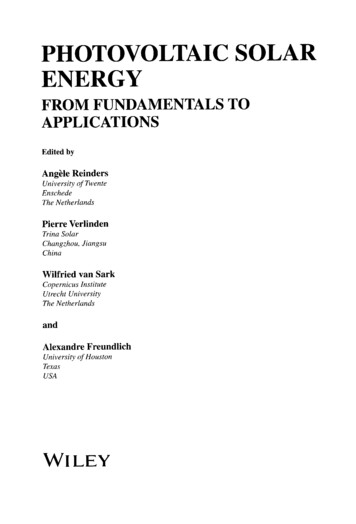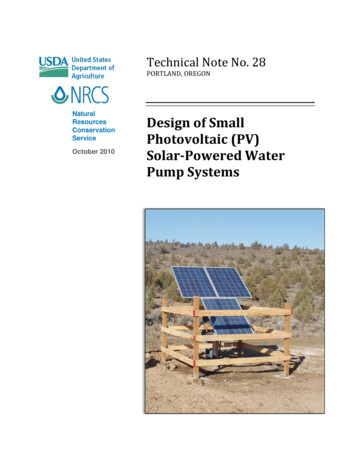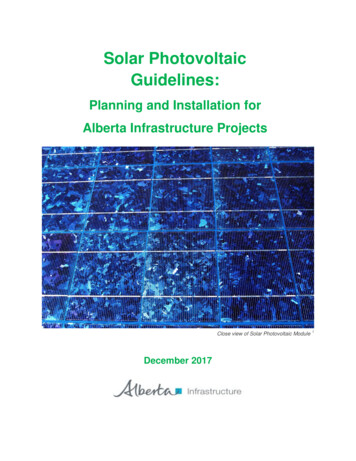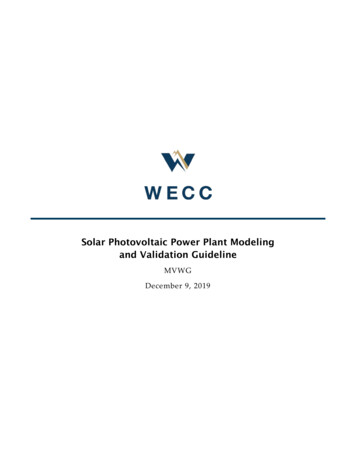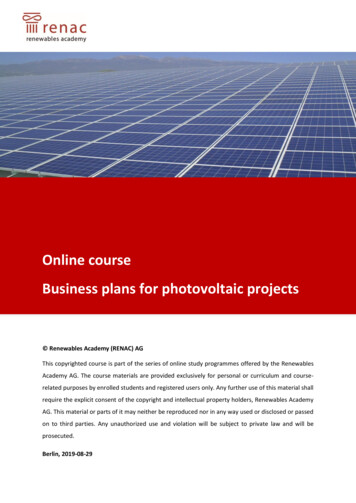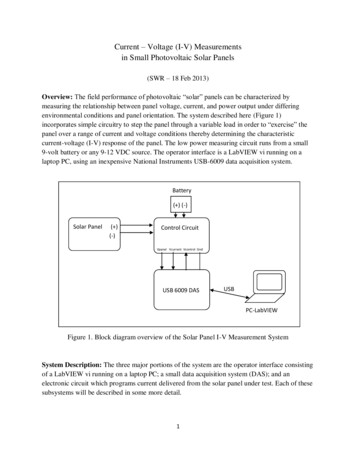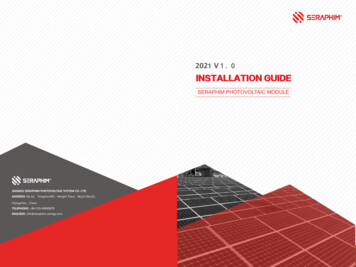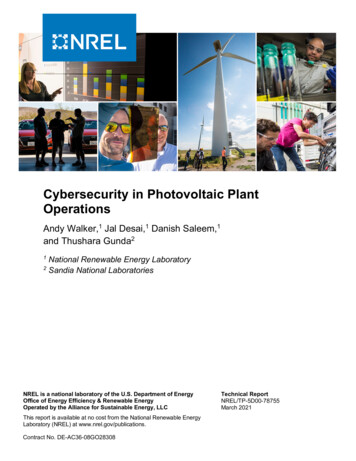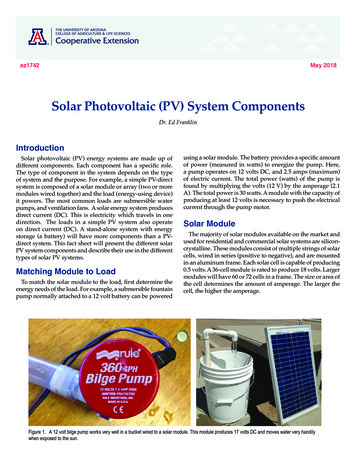
Transcription
az1742May 2018Solar Photovoltaic (PV) System ComponentsDr. Ed FranklinIntroductionSolar photovoltaic (PV) energy systems are made up ofdifferent components. Each component has a specific role.The type of component in the system depends on the typeof system and the purpose. For example, a simple PV-directsystem is composed of a solar module or array (two or moremodules wired together) and the load (energy-using device)it powers. The most common loads are submersible waterpumps, and ventilation fans. A solar energy system producesdirect current (DC). This is electricity which travels in onedirection. The loads in a simple PV system also operateon direct current (DC). A stand-alone system with energystorage (a battery) will have more components than a PVdirect system. This fact sheet will present the different solarPV system components and describe their use in the differenttypes of solar PV systems.Matching Module to LoadTo match the solar module to the load, first determine theenergy needs of the load. For example, a submersible fountainpump normally attached to a 12 volt battery can be poweredusing a solar module. The battery provides a specific amountof power (measured in watts) to energize the pump. Here,a pump operates on 12 volts DC, and 2.5 amps (maximum)of electric current. The total power (watts) of the pump isfound by multiplying the volts (12 V) by the amperage (2.1A). The total power is 30 watts. A module with the capacity ofproducing at least 12 volts is necessary to push the electricalcurrent through the pump motor.Solar ModuleThe majority of solar modules available on the market andused for residential and commercial solar systems are siliconcrystalline. These modules consist of multiple strings of solarcells, wired in series (positive to negative), and are mountedin an aluminum frame. Each solar cell is capable of producing0.5 volts. A 36-cell module is rated to produce 18 volts. Largermodules will have 60 or 72 cells in a frame. The size or area ofthe cell determines the amount of amperage. The larger thecell, the higher the amperage.Figure 1. A 12 volt bilge pump works very well in a bucket wired to a solar module. This module produces 17 volts DC and moves water very handilywhen exposed to the sun.
Source: NRELSource: AuthorSource: AuthorSource: Nunutak EnergyCourtesy of NREL.govFigure 2. The solar cell is the basic component. Cells wired togetherand mounted in a frame compose a solar module. Several moduleswired together form an array.Figure 4. Modules mounted together on racks and wired togtherto create series strings. Arrays can be pole-mounted (left), groundmounted (right). Roof-top arrays can be mounted using flat-roofrackinging, and pitched-roof mounting systemswatt module rated at 17.2 volts and 1.2 amps is wired in seriesto second similar module. The result is a series string capableof producing 34.4 volts (17.2V 17.2V 34.4V). However, thecurrent each module produces, stays the same.Figure 3. Examples of mono-crystalline (left) and poly-crystallinesolar PV modules. Mono-crystalline were first produced and usedby NASA and the US military. Poly-crystalline are less expensive,and found world-wide on the renewable energy market.Early modules were mono-crystalline and had round cells.The manufacturing process resulted in a more efficient cell,but resulted in waste, and is an expensive process. Today’scrystalline modules are poly-crystalline and are cut into squareor rectangular-shaped cells. The process wastes less material,but produces a less efficient module. However, decreased costshas made it a competitive process.Solar ArrayThe solar array is made up of multiple PV modules wiredtogether. Connecting the negative (-) wire of one module tothe positive ( ) wire of a second module is the beginning of aseries string. Wiring modules in series results in the voltage ofeach of the two modules is added together. For example, a 202The University of Arizona Cooperative ExtensionA series string represents the summed voltages of eachindividual module. Each module should be the same voltageand current. The negative cable of one module is connectedto the positive cable of the next module. In a large system,multiple strings are assembled and the non-connected ends areconnected to homerun leads which are landed at the terminalsof an enclosure located near the array. For example, if an arrayis made up of a string of 10 modules, each rated at 30 voltsand 4 amps, the string would be rated at producing 300 volts(10 x 30 volts) and 4 amps, or a total of 1,200 watts (1.2 kW).The goal is to wire modules in series to build voltage. Sincethe AC voltage in a residence operates on 120 to 240 volts, itis desirable to achieve the voltage necessary to operate theloads in the residenceCombiner BoxA PV system array with multiple strings of modules willhave a positive lead and a negative lead on the end of eachstring. The positive leads will be connected to individualfuses and the negative leads will be connected to a negativebusbar in an enclosure. This is called the source circuit. Thecombiner box serves to “combine” multiple series strings intoone parallel circuit. For example, an array with three stringsof 10 modules wired in series would produce 300 volts (10modules x 30 volts) per string and 4 amps per string. Whenthe leads are landed in the combiner box, the circuit wouldproduce 300 volts at 12 amps (3 strings x 4 amps/string). Oncethe circuits are combined, leaving the box it is referred to asthe “output circuit”.
Source: AltE StoreSource: WileySource: AuthorFigure 5. Examples of different size combiner boxes. The positive ( ) lead is connected to the fuse. The negative (-) lead is connectedto grounded buss bar. The box on the left supports two strings. The box in the center supports four strings. The box on the right is acommercial-sized combiner box supporting several strings.Figure 6. Three strings of 10 PV modules, each rated at 35.4 volts max power (Vmp) and 4.95 Amps are wired in series. Each string hasa total volts max power of 354 volts max power (Vmp) and 4.95 Amps, (current, max power --- Imp). The positive ( ) lead from each stringis connected a fuse, and the three are connected to an output circuit. The negative (-) leads from the three series strings are landed onto abus bar in the combiner box. The output circuit is a result of the parallel connection. The 30 modules are expected to produce 354 volts maxpower (Vmp) and 14.85 amps max power (Imp). The solar array is capable of producing 5,257 watts (5.3 kilowatts) of power.PV DisconnectA direct current (DC) disconnect switch is installed betweenthe inverter load and the solar array. The disconnect switch isused to safely de-energize the array and isolate the inverterfrom the power source. The switch is sized to fit the voltage ofthe solar array and is connected to the ungrounded conductor.On a solar PV system, the ungrounded conductor is usuallythe positive ( ) conductor. The negative (-) conductors aregrounded, and a ground conductor bonds the system to anelectric ground, as required by the local electrical code. Localutilities may require disconnects accessible by utility personnelon a grid-connected PV system. Another disconnect, on theAC-side of the inverter, is installed before the AC service panel.The AC disconnect serves to isolate the inverter from the ACservice panel in a grid-connect PV system.The University of Arizona Cooperative Extension3
Source: AuthorFigure 7. Examples of DC safety disconnect switch boxes. Theone on the left is part of an active solar array. The box is properlylabeled as a PV DC disconnect switch with the amount of energycoming through it.Source: AltE StoreFigure 9. An example of a larger-sized battery charger. This modelis rated for a range of 12 volts to 48 volts, and 30 amps. Controllersregulate energy.Charge ControllerSource: AuthorA charge controller regulates the amount of charge goinginto the battery from the module to keep from overchargingthe battery. Charge controllers can vary in the amount ofamperage they can regulate. Some models will includeadditional features such as connecting and operating DC loads,and regulating energy going to a load based on the amount ofcharge in a battery. During daylight, the array sends powerto the controller and to the battery. The controller monitorsthe level of energy to keep the battery fully charged. At night,when the array is not sending energy, the controller allows thebattery to energize the load as demanded.BatterySource: AuthorFigure 8. Examples of smaller-sized charger controllers. Exampleon top is rated for 10 amps, and example on bottom is rated for 15amps.4The University of Arizona Cooperative ExtensionWhen solar energy is to be stored for use when the sun is notshining, a battery is used. The most commonly used battery forresidential PV applications is the lead-acid battery. The solaruser should look for a deep-cycle battery, similar to what isused in a golf cart, but designed for renewable energy systems.There are two types of lead-acid batteries: flooded lead-acid(FLA), sealed absorbed glass mat (AGM). The battery voltagecan vary from 2, 6, and 12 volts. Individual amp-hours canvary. For example, battery “A” (pictured below) is rated at12 volts, and 35 amp-hours, while battery “B” is rated at 12volts and 58 amp-hours. Dimensions of individual batteriescan vary.
Battery “A”Source: AuthorFigure 10. Example of a sealed lead-acid solar battery. Rating at12 volts – 35 amp-hours.Battery “B”Battery BanksIf the total voltage needs is greater than what one batterycan provide, a number of batteries are connected togetherto form a bank. For example, two 12-volt batteries wired inseries (positive terminal to negative terminal), produces abattery bank capable of providing up to 24 volts of DC energy,and four batteries wired in series produces 48 volts. Batterybanks are sized to allow loads to operate for multiple daysduring cloudy weather conditions when the array is not ableto charge the battery bank. Batteries have a limited life cycle.A cycle consists of discharging a battery and recharging itto full capacity. The life cycle of a battery can be lengthenedif the battery is not discharged all the way to 0% charge. Areasonable design is to have batteries discharge to 50% thenrecharge to full. However, this design may require havingmore batteries in the bank. Batteries used in solar systemsare classified as deep-cycle batteries and may be dischargedup to 80% of its storage capacity.Source: AuthorFigure 11 An example of a gel battery, rated at 12 volts and 58amp-hours.Source: AuthorFigure 14. A bank of 6 volt batteries connected in a series string.Batteries store DC energy.Source: AuthorFigure 12. Two sealed solar batteries. The battery on left is ratedat 6 volts, 12 amp-hours, and the battery on the right is rated at 12volts, 7 amp-hours.Figure 13. A lead-acid deep-cycle battery that requires servicing.Figure 15. A bank of two strings of 2 volt batteries wired in series.Each string is 12 volts.The University of Arizona Cooperative Extension5
InvertersEnergy from an array or a battery bank is direct current(DC). This will provide for DC loads such a lights, fans,pumps, motors, and some specialty equipment. However,if the energy is to be used to power loads that operate onalternating current (AC), as what is found in a residence, thecurrent needs to be converted. The inverter changes DC energyto AC energy. Inverters are available in many different sizesfor various-sized loads. A small inverter can be plugged intothe power outlet of a vehicle to change the 12 volt DC energyfrom the vehicle’s battery, to 120 volt AC energy to power alaptop computer. Larger inverters are available to power largerloads. For example, a 4000 watt inverter can be connected to a12 volt battery and used for energizing small AC appliances.A string inverter is used to convert DC power from a solararray to AC power and can be connected to an AC distributionpower panel (service panel) in a residence or facility. Stringinverters are available in different sizes depending on the sizeof the AC loads.AC Disconnect SwitchSafety disconnect switch are required by the NationalElectric Code (NEC) on the AC-side of the inverter to safelydisconnect and isolate the inverter from the AC circuit. Thisis for troubleshooting and performing maintenance on thesystem. For grid-connected systems, this component may berequired by the local utility.AC Breaker PanelIn a residence or commercial business receiving electricalenergy from a local utility, the AC energy is tied into a serviceentrance panel (SEP). The panel consists of circuit breakers anddivides the service into separate branch circuits. A circuit mayprovide 120 volts or 240 volts. The size of the circuit dependson the size of the loads. Household circuits are sized at 15 ampsof current. Larger circuits of 20 amps, 30 amps, or 50 amps,are found where larger appliances or electrical equipmentare used. A grid-connected PV system will have a circuitconnecting the AC-side of the inverter to the AC service panel.Figure 16. A string inverter connected in a system converts DC energy from the solar array to AC energy suitable for household power.Inverters come in various sizes based on total system power (wattage). A string inverter connected to a grid-direct system (sending energyto the local utility) detects utility-supplied energy blackouts and will automatically shut down for safety reasons. The inverter does not storeenergy, but converts it. If the array is not producing enough energy (lack of sunlight), the inverter will shut down.Figure 17. Examples of AC safety disconnect switch boxes.6The University of Arizona Cooperative Extension
to the Extension factsheet, “Demystifying the Solar Module”(AZ1701) for information about solar PV modules. Simplesystems have fewer components, but are limited to providingenergy when the sun is shining. More complex systemsha
Solar photovoltaic (PV) energy systems are made up of . different components. Each component has a specific role. The type of component in the system depends on the type of system and the purpose. For example, a simple PV-direct system is composed of a solar module or array (two or more modules wired together) and the load (energy-using device) it powers. The most common loads are submersible .
